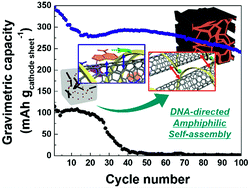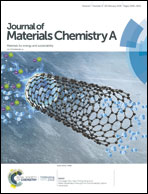DNA-directed amphiphilic self-assembly as a chemifunctional/multiscale-structuring strategy for high-performance Li–S batteries†
Abstract
Deoxyribonucleic acid (DNA)-based self-assembly has garnered considerable attention as a high-fidelity ‘bottom-up’ fabrication technique. Herein, intrigued by the amphiphilic nature of DNA molecules, we demonstrate a new class of DNA-directed amphiphilic self-assembly as a chemifunctional/multiscale-structuring strategy, beyond the previously reported DNA-mediated assemblies, and explore its potential application to lithium–sulfur (Li–S) batteries as a proof-of-concept. DNA-directed amphiphilic self-assembly enables the formation of various structures with a wide range of dimensional scales and exceptionally low bundle/junction electrical resistance, which are difficult to achieve with conventional DNA-mediated assemblies. The amphiphilic DNA molecules interact with single-walled carbon nanotubes (SWCNTs) through hydrophobic π–π stacking and divalent metal ions via electrostatic interaction. This results in electrically conductive DNA/SWCNT foams with hierarchical multiscale porous structures that can act as functional scaffolds of Li–S battery cathodes. Benefiting from the above-described advantageous effects, the DNA/SWCNT scaffold allows the resultant Li–S battery to provide significantly improved electrochemical performance.



 Please wait while we load your content...
Please wait while we load your content...